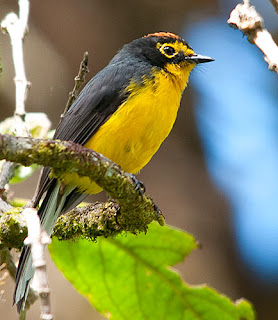 |
| Cotopaxi National Forest |
Straddling the equator from which it takes its name, Ecuador encompasses an area of 285,561 sq. km. (109,415 sq. mi.). UNESCO designated the capital, Quito, as a World Heritage Site in 1978, along with the Galapagos Islands. Sangay National Park was later designate as a WHS in 1981 and the city of Cuenca in 1999.
In spite of its small size, slightly smaller than the country of Italy, it boasts more species of birds than the United States and Europe combined and has over half of the known species of birds on the continent of South America. With over 1600 species registered, they have 22 avian orders with 82 families represented in the country. Ecuador has 42 endemic species and 77 species that are globally threatened.
In 2005 Ecuador became the first country in the Southern Hemisphere to recognize Important Bird Areas (IBAs) as sites of public interest. The first IBA was recognized in 1997, registering the “Mindo and Northwestern Pichincha Volcano” area. Since then, 106 more areas have been identified in the Galapagos, the coast, the Andean highlands and the Amazon basin
Oriente (Amazon Basin)
The Oriente or Amazon Basin can be divided into two distinct regions; the High Amazon, which comprises the foothills of the Andes, and the Amazon Lowlands, which are further east and provide the river drainage to the Amazon River. The more important of these rivers are the Napo, the Pastaza and the Putumayo. The Oriente is the least densely populated of the four main regions. Because of this the 7 Important Bird Areas cover a much larger territory.The Sierra or Andes Mountain Range divides the mainland from north to south. This in turn is divided into two ranges: the Occidental or Western Range, which descends to the coast and the Oriental, or Eastern Range, which gradually descends to the Amazon Basin. Between these two ranges is the Inter-Andean valley or plateau, which can reach altitudes of 3000 meters (10,000 ft.). Throughout this region are numerous volcanoes reaching heights of 6,310 meters (20,800 feet). This is the most diverse area for birding with different species inhabiting various altitude ranges from 1000 meters (3,300 feet) in the coastal and Amazon basin regions to 4000 meters (13,200 feet) in the Andes. There are 59 designated Important Bird Areas throughout the Sierra.
Coast
The coast, or western lowlands, has about 640 km (400 mi.) of coastline as well as several islands. It is comprised of fertile plains, rolling hills and sedimentary basins. Numerous rivers crisscross the region, providing habitat for various species of birds. There are 31 designated Important Bird Areas along the coast that accommodate many endemic species as well as several threatened birds. Isla de la Plata, about 30 km (20 mi) off the coast of Puerto Lopez is referred to as 'Little Galapagos' as it provides refuge for many of the more popular birds found on the archipelago such as the Magnificent Frigate bird, Waved Albatross and the Blue-footed BoobyCoast
 |
| Nazca Boobies (Sula granti) |
Galapagos
The Galapagos Islands, also known as the Archipelago of Colón, is situated about 1000 km (625 miles) off the coast of Ecuador. It is a volcanically formed group consisting of 15 main islands, 3 smaller islands and 107 rocks and islets. In all it encompasses 7,880 sq. km (3040 sq. mi.) spread over an area of 45,000 sq. km. (17,000 sq. mi.) of ocean. The temperatures ranges from 22-25 C (72-77 F) all year round. The entire Archipelago is considered national park and there is a $100 ($6 for nationals) entrance fee to the islands. Altitudes range from sea level to 1,600 meters (5,260 feet).
There are 28 endemic bird species on the islands and BirdLife International has designated 10 areas as Important Bird Areas.
Access and Facilities
Air travel is available into both of Ecuador's major cities: Quito and Guayaquil. Quito is situated in the Andes Mountains and provides access to the northwestern and northeastern regions of the country. Guayaquil is located further south on the coast and provides access to the southwest and southeast. Anyone going to the Galapagos Islands can fly into either city. |
| Golden-headed Quetzal (Pharomachrus auriceps) |
Most birding areas can be reached either by public transportation or private vehicle with the exception of some of the birding areas in the Amazon basin. These will require access by chartered aircraft or by canoe. If traveling by private vehicle it is recommended to have an auto with a high clearance, as some of the access roads can be rough.
Both Quito and Guayaquil are modern cities with all the amenities expected of such. Hotels range from budget to 5 stars. Food also varies with many international restaurants featuring cuisine from numerous countries. However, one is cautioned to eat wisely when visiting some of the cheaper eateries to avoid unwanted side-affects.
When traveling away from the two major cities the accommodations are less formal, and less expensive. There are many hostels and hosterias that provide adequate rooms for a reasonable price. There are also several lodges, which provide all the amenities one could want.
There are numerous travel agencies providing birding tours and packages. They can range from the very expensive to the more frugal. Most major areas have independent bird guides but choose wisely as many do not speak adequate English or may not be as well versed in the avifauna as they claim.






















